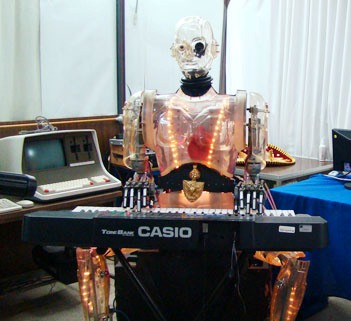By José Alberto Gaytán García *
It is the title of an entertaining and interesting book written by Adriana Malvido who published the National Council for Culture and the Arts (CONACULTA). I found this book in a bookstore a few days ago in the city of Xalapa. The title caught my eye because its entry reminded me, as a good Veracruzano, those romantic verses of The Tropical Village, song written by the great musician and composer Gonzalo Curiel from Jalisco, saying “I’m on the tropical footpath, the quiet night with its scent of moisture …”
In the case of the book by Adriana Malvido, the issue addressed is far from being romantic and tropical, on the contrary, it’s even worrisome, and it has to be since its reading contains a strong wake up call to warn us that although we are late in accepting it or recognizing it, the challenging and unstoppable future reached us in many ways. In this sense, the author of the book examines the forms and the radical changes that the human culture will experience in their clash with the many faces of the digital revolution. The author tells us, that in this digital age revolution, it is enough to simply click on the computer to break the barriers of time and space and cites some examples: in one click you can get a welcome from Georges Pompidou Museum of Modern Art in Paris with full details of all its exhibitions or with another click we can enter a virtual store of Apple in the third dimension.

The reading of The digital trail is entertaining, informative and recommended for anyone interested in the subject of the digital revolution, especially for students, teachers and researchers in the computer world. Virtual reality, e-mail, interactive media, how was the Internet born?, Who is behind the Internet?, Multimedia, robotics, etc., are some of the topics contained in the book, which by the way, its title is part of the terminology that has the list of the new reference material to which we will have to get accustomed in the digital revolution of the third millennium.
In the new digital era, where every four seconds a user is connected to the largest computer network in the world (Internet) we will have to get used to things never before seen or heard, for example, there will be changes in all spheres of our life, in dressing, in eating, in purchasing and these changes will be imposed by the fact that in the next decade, one way or another, everyone on the planet will be connected on the web or Internet.
In accordance with the in-depth reading of the book, there is acquired a clear idea of the brutal technological dimension which will dominate society in the new millennium. This dominance will be mainly in the imposition of new customs and ways of living, which also alter the economy, politics, science, education and the scale of moral, ethical and religious values.
The result or balance of the shock of the digital era against the foundations of the current civilization, we still neither know it, nor know what will happen. We do not know if today’s society will scatter into thousands of isolated internet users, we only know that all this digital age began when Mario Bros and its generation of Atari replaced the generation that played spin a top, cup and ball and marbles in our country while we innocently sang those school songs called “the sea snake” and “Mambu went to war”. Then, Mario Bros was replaced by Playstation and XBox, the latter, will be replaced by the generation of “ciberkids” that play with amazing digital toys.
The culture and the music also are a part of the issues that will not escape the technological revolution of the Third Millennium and in this sense, we will see become extinct little by little those romantic business where the people would gather in the evenings to enjoy a good cup of coffee and quietly comment on the news of the day; in those places, in the distance singing could be heard from a folk singer or cheerful notes of the marimba, however, this romantic reference shakes off violently when we find in the reading of the mentioned book completely opposite references, as the data that appears on page 51, which speaks of a talented pianist who has given over two thousand concerts in major venues in the world. The famous musician is called “the handsome Cuco”, “Cuco el Guapo”. He was born in a laboratory at the University of Puebla, is made of iron covered with acrylic, his brain is a 16-bit chip and his movements are executed with mathematical models. His right eye has adapted a special video system that allows him to recognize and read musical notes.

This robot and his robotic family siblings will be in charge of creating music that will take on the digital path to future generations, as did in their time Agustin Lara, Toña La Negra, the Martinez Gil or the same Gonzalo Curiel, who took us by the hand by The Tropical Village, as we reflect fondly on such beautiful memories. Watchout! Because the future has arrived.
jalbertogaytangarcia@gmail.com
A23R6/17
Acerca del autor

- José Alberto Gaytán García ha escrito artículos y ensayos de corte académico en diarios y revistas de México y de los Estados Unidos; ha participado en importantes proyectos académicos e impartido conferencias sobre temas de historia, tecnología y educación en el marco de las relaciones entre México y los Estados Unidos, tema en el cual realizó sus estudios de doctorado en The Graduate School of Internacional Studies de la Universidad de Miami.
 Cultura General10 agosto, 2022Michio Kaku: científico del futuro
Cultura General10 agosto, 2022Michio Kaku: científico del futuro Cultura General29 junio, 2020Miguel Alcubierre: viajero de las estrellas
Cultura General29 junio, 2020Miguel Alcubierre: viajero de las estrellas Cultura General6 abril, 2020Niños brillantes (Segunda parte)
Cultura General6 abril, 2020Niños brillantes (Segunda parte) Cultura General6 abril, 2020Niños brillantes (Primera parte)
Cultura General6 abril, 2020Niños brillantes (Primera parte)




